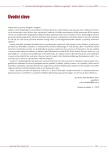Veins and diabetes
Authors:
S. Kašpar
Authors‘ workplace:
Centrum žilní chirurgie Hradec Králové, přednosta MU Dr. Svatopluk Kašpar, Ph. D.
Published in:
Vnitř Lék 2010; 56(4): 329-332
Category:
11th National Diabetes Symposium "Diabetes and Angiology", Hradec Kralove, 5 to 6 June 2009
Overview
Patients with trophic ulcers of lower extremities are relatively frequently diagnosed with diabetes mellitus with venous aetiology being the cause of these defects in up to 70% of patients. Chronic venous insufficiency most frequently results from primary venous insufficiency (mostly lower limb varices) or occurs secondarily as a result of deep vein thrombosis. Lower limb varices are common in human population; they affect 20– 25% of women and 10– 15% of men, and the incidence increases with age. With respect to radicality of treatment approaches, surgical management is unequivocally considered as the most effective. Apart from the traditional open surgery, clinical practice of the recent years has seen the advance of mini‑invasive endovascular methods to treat varices of the main (stem) veins – radiofrequency and laser thermocoagulation. The main principle behind radiofrequency ablation is thermocoagulation of insufficient saphenous vein by bipolar radiofrequency current; endovenous laser uses, for the same purpose, energy of a beam of light. Both methods inactivate the insufficient veins while leaving them in the patient body. Thermal damage of the pathological venous wall leads to contraction and obliteration of the vein and, gradually, to its full resorption. Apart from minimizing recurrence, the technique is also valuable with respect to its cosmetic effect and gentleness of the procedure, allowing fast return to full activity. Studies comparing endovascular interventions with the traditional surgeries confirmed that radiofrequency or laser techniques are safe and well tolerated with the outcomes fully comparable to open surgery in its modern form.
Key words:
chronic venous insufficiency – varicose veins of lower extremities – radiofrequency ablation – endovenous laser
Sources
1. Margolis DJ, Knauss J, Bilker W. Medical conditions associated with venous leg ulcers. Br J Dermatol 2004; 150: 267– 273.
2. Moffatt CJ, Franks PJ, Doherty DC et al. Prevalence of leg ulceration in a London population. QJM 2004; 97: 431– 437.
3. Phillips TJ. Chronic cutaneous ulcers: etiology and epidemiology. J Invest Dermatol 1994; 102: 38S– 41S.
4. Callam MJ. Epidemiology of varicose veins. Br J Surg 1994; 81: 167– 173.
5. Herman J et al. Chirurgie varixů dolních končetin. Praha: Grada Publishing 2003.
6. Mazuch J. Varixy dolných končatín v klinickej praxi. Martin: Osveta 1988.
7. Hejhal P, Firt P, Livora D. Endovaskulární koagulace povrchových žilních městků dolních končetin. Rozhl Chir 1959; 37: 418– 425.
8. Politowski M, Zelazny T. Complications and difficulties in electrocoagulation of varices of the lower extremities. Surgery 1966; 59: 932– 934.
9. Watts GT. Endovenous diathermy destruction of internal saphenous. Br Med J 1972; 4: 53.
10. Goldman MP. Closure of the greater saphenous vein with endoluminal radiofrequency thermal heating of the vein wall in combination with ambulatory phlebectomy: preliminary 6- month follow‑up. Dermatol Surg 2000; 26: 452– 456.
11. Navarro L, Min RJ, Boné C. Endovenous laser: a new minimally invasive method of treatment for varicose veins. Preliminary observations using an 810 nm diode laser. Dermatol Surg 2001; 27: 117– 122.
12. Proebstle TM, Lehr HA, Kargl A et al. Endovenous treatment of the greater saphenous vein with a 940- nm diode laser: thrombotic occlusion after endoluminal thermal damage by laser‑ generated steam bubbles. J Vasc Surg 2002; 35: 729– 736.
13. Min RJ, Khilnani NM. Endovenous laser ablation of varicose veins. J Cardiovasc Surg (Torino) 2005; 46: 395– 405.
14. Kaspar S, Siller J, Cervinkova Z et al. Standardisation of parameters during endovenous laser therapy of truncal varicose veins – experimental ex‑ vivo study. Eur J Vasc Endovasc Surg 2007; 34: 224– 228.
15. Kašpar S. Endovaskulární terapie varixů dolních končetin. In: Mazuch J et al (eds). Chirurgické aspekty chronickej venóznej insuficiencie dolných končatín. Martin: Osveta 2006.
16. Kašpar S, Pirkl M, Příborská J et al. Šest let zkušeností s endovenózním laserem v terapii varixů dolních končetin. Rozhl Chir 2009; 88: 106– 114.
17. Lurie F, Creton D, Eklof B et al. Prospective randomised study of endovenous radiofrequency obliteration (closure) versus ligation and vein stripping (EVOLVeS): two‑year follow‑up. Eur J Vasc Endovasc Surg 2005; 29: 67– 73.
18. Merchant RF, Pichot O. Closure Study Group. Long‑term outcomes of endovenous radiofrequency obliteration of saphenous reflux as a treatment for superficial venous insufficiency. J Vasc Surg 2005; 42: 502– 509.
19. Pichot O, Kabnick LS, Creton D et al. Duplex ultrasound scan findings two years after great saphenous vein radiofrequency endovenous obliteration. J Vasc Surg 2004; 39: 189– 195.
20. Perälä J, Rautio T, Biancari F et al. Radiofrequency endovenous obliteration versus stripping of the long saphenous vein in the management of primary varicose veins: 3‑year outcome of a randomized study. Ann Vasc Surg 2005; 19: 669– 672.
21. Hinchliffe RJ, Ubhi J, Beech A et al. A prospective randomised controlled trial of VNUS closure versus surgery for the treatment of recurrent long saphenous varicose veins. Eur J Vasc Endovasc Surg 2006; 31: 212– 218.
22. de Medeiros CA, Luccas GC. Comparison of endovenous treatment with an 810 nm laser versus conventional stripping of the great saphenous vein in patients with primary varicose veins. Dermatol Surg 2005; 31: 1685– 1694.
23. Rasmussen LH, Bjoern L, Lawaetz M et al. Randomized trial comparing endovenous laser ablation of the great saphenous vein with high ligation and stripping in patients with varicose veins: short‑term results. J Vasc Surg 2007; 46: 308– 315.
24. Mekako AI, Hatfield J, Bryce J et al. A nonrandomised controlled trial of endovenous laser therapy and surgery in the treatment of varicose veins. Ann Vasc Surg 2006; 20: 451– 457.
Labels
Diabetology Endocrinology Internal medicineArticle was published in
Internal Medicine

2010 Issue 4
Most read in this issue
- Angiopathy and the eye
- Peripheral arterial disease and diabetes
- Surgical treatment of ischemic heart disease and diabetes mellitus
- Diabetes mellitus and ischemic heart disease
